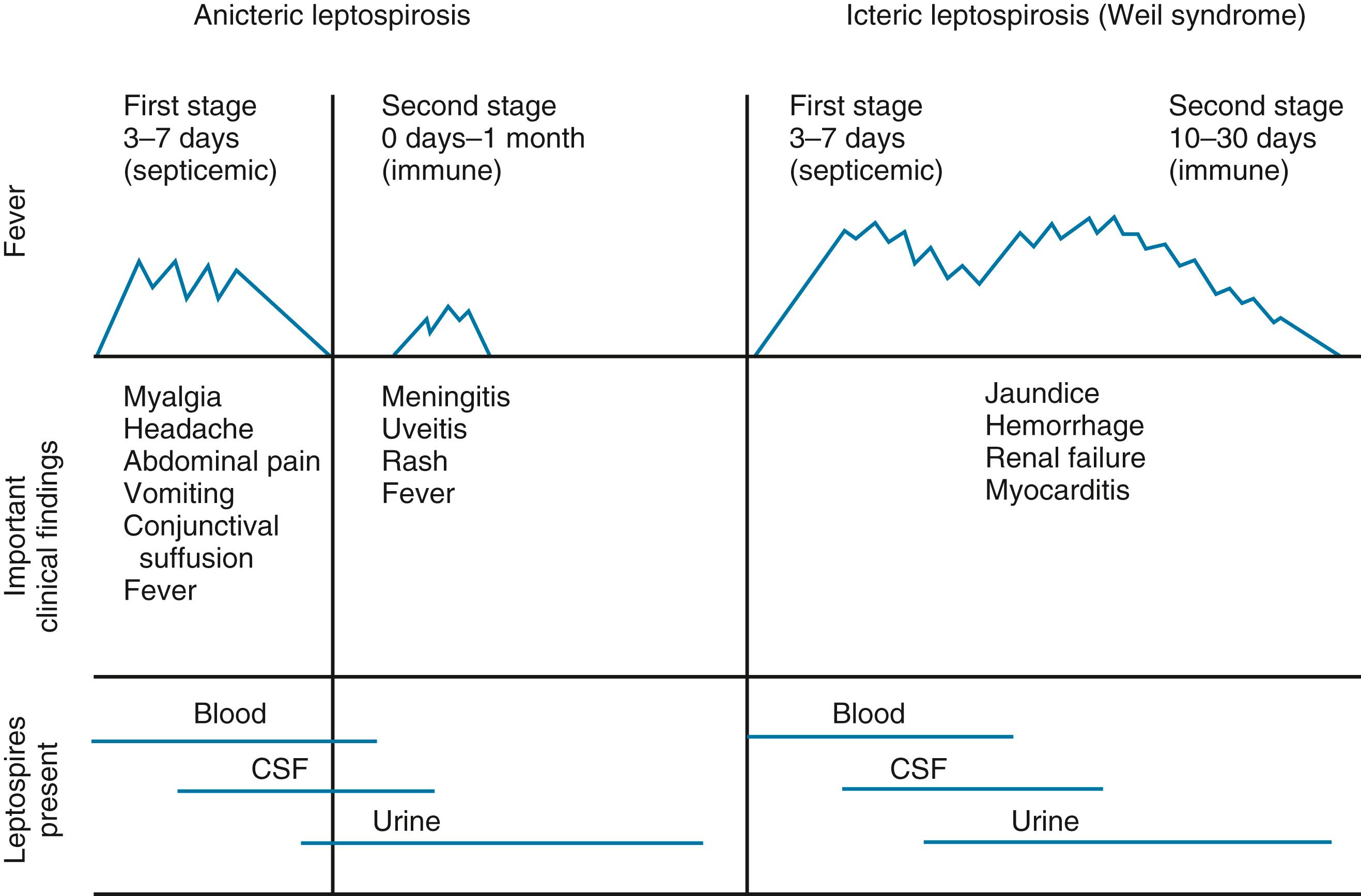Physical Address
304 North Cardinal St.
Dorchester Center, MA 02124
Substantial contributions of Eugene D. Shapiro to this chapter in previous editions are recognized with gratitude.
The Leptospira genus consists of a group of motile, finely coiled, catalase-producing spirochetal bacteria that are obligate aerobes . The Leptospira genus is classified into at least 20 species and genomospecies. L. biflexa is a free-living saprophytic organism that is found in water and soil and does not cause human disease. At least 8 other species, including L. interrogans, are highly pathogenic for humans, and several others are intermediately pathogenic. Serologic classification is important because specific serogroups (>25) and serovars (>250) are associated with specific animal species and vary in their pathogenicity and virulence for humans. The application of molecular genetic techniques to understanding the biology of the organism and the mechanisms by which Leptospira organisms are pathogenic for humans is beginning to provide new insights into this ancient disease. Stimson, who first saw the organism under the microscope in 1907, named it interrogans because it was shaped like a question mark.
Pathogenic Leptospira organisms infect humans through intact mucous membranes or disrupted skin, invade the bloodstream, and disseminate rapidly to multiple organs. Although the precise mechanism by which Leptospira causes disease has not been defined, tissue injury is apparently mediated by direct effects of the bacterium.
Leptospira organisms have a predilection for infecting the liver and kidney, although any tissue can be infected. Infection can cause hepatocellular dysfunction, which can lead to jaundice, in most instances without hepatocellular necrosis. Infection also can cause renal tubular dysfunction resulting in renal failure and hemorrhagic vasculitis. The signs and symptoms of leptospirosis during the initial “septicemic” phase of illness are caused by a direct effect of the organism; inflammation during the second or “immune” phase of the illness is related to antigen-antibody complexes.
Leptospirosis is a zoonosis, and infection with Leptospira is widespread in both wild and domestic animals throughout the world. Humans are incidental hosts and, with the low concentrations of bacteria in the urine of those infected, rarely contribute to transmission or maintenance of Leptospira in nature. By contrast, Leptospira can be shed in the urine of wild animals such as rodents (particularly mice and rats) and by domestic animals such as dogs, cows, and pigs for long periods. Such animals serve as reservoirs for the organism and their urine contaminates the water and soil, where Leptospira can survive for weeks.
The epidemiology of human leptospirosis largely is determined by the nature of the contact between humans and infected animals and the level of sanitation in the community. Infection in humans often occurs through contact with the animal urine, either directly or by contaminated water or soil; human infection also can occur through contact with organs of infected animals. In developing countries, rats are the primary reservoir for leptospirosis. In the US, dogs and farm animals are important reservoirs in addition to rats. However, Leptospira also have been identified in many wild mammals such as raccoons, foxes, skunks, opossums, and wolves; in Western Europe, smaller rodents and mustelid species have been described as renal carriers. Although any animal can be infected with any serovar of Leptospira, certain serovars seem to infect certain species preferentially. For example, L. interrogans serovar pomona is isolated most frequently from cows and pigs, serovar canicola from dogs, and serovar icterohaemorrhagiae from rats and mice. The prevalence of infection in certain animal species is high. Up to 90% of Norway rats have been found to be infected with L. interrogans; once infection is established in rats, L. interrogans is shed for life. Many other animals, such as dogs (even those immunized), cattle, and pigs, can shed high concentrations of Leptospira in urine for months after the initial infection, but shedding diminishes substantially or halts within 6–12 months. Organisms survive for 3 months or more in neutral or slightly alkaline water but not in acidic environments.
People with occupational, recreational, or accidental contact have an increased risk for leptospirosis. In the US, most cases are reported from the southern states, which may reflect high year-round potential for exposure. In tropical and subtropical areas, seasonal peaks associated with the rainy season have been described. The influence of climate and environmental factors in the epidemiology is depicted also by the increased risk for leptospirosis in areas prone to flooding ; a recent study from Puerto Rico showed a correlation with proximity of residence to a canal. In temperate regions, cases and common source outbreaks have been associated with aquatic recreational activities (canoeing, kayaking, triathlon, swimming). Travelers engaging in freshwater-related sports and ecotourism have also acquired leptospirosis. Increased occupational risk exists for people who live or work on dairy, cattle, or pig farms, as well as abattoir (slaughterhouse) workers and veterinarians.
The incidence of leptospirosis is unknown because most cases either are asymptomatic or are diagnosed incorrectly. The diagnosis most often is made in teenage boys and young men, presumably because their activities expose them more frequently to the urine of infected animals. However, infection can occur regardless of age or sex. , , Children usually become infected by exposure to stagnant, contaminated water. Exposure risk increases with age, as suggested by a recent study from India showing increased seroprevalence in adolescents compared with infants and younger children.
The incubation period is approximately 10 days (usual range, 7–14 days), although incubation can be as short as 2 days and as long as 25 days. Clinical manifestations are divided into the initial “septicemic” phase and the subsequent “immune” phase. The severity of illness ranges from the classic, icteric Weil syndrome (which affects ∼10% of patients) to the more common, less severe anicteric form of leptospirosis. The correlations between fever, clinical findings, and the presence of organisms in body fluids in the different stages of disease are shown in Fig. 184.1 .

Become a Clinical Tree membership for Full access and enjoy Unlimited articles
If you are a member. Log in here